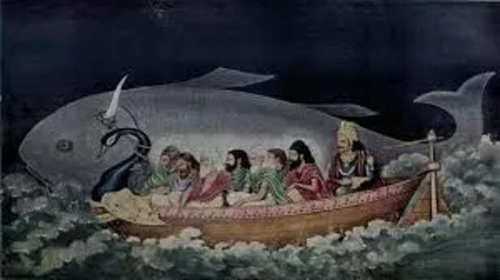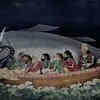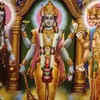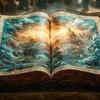
Hindu mythology is frequently viewed as an intricate weaving of captivating deities, celestial conflicts, and deep philosophies. However, what may astonish you is the extent to which it parallels other significant religions globally. From stories of creation to ethical principles, the reverberations of Hinduism are noticeable throughout numerous spiritual customs.
1. Creation Myths: The Beginning of Everything

(Image Source : Dreamstime)
In Hinduism, the Rigveda’s Nasadiya Sukta describes the creation of the universe in a way that is eerily similar to the biblical account in Christianity and Judaism. It speaks of a time when there was no existence, no non-existence, no death, and no immortality a formless void.
Hinduism: The story of Brahma, the creator god, emerging from a cosmic golden egg (Hiranyagarbha) resonates with the idea of creation springing from nothingness.
Christianity and Judaism: The Book of Genesis describes God creating the universe out of a void, speaking light and life into existence.
Greek Mythology: Chaos, the primordial void, gives birth to Gaia (Earth) and Uranus (Sky), akin to the union of Prakriti (nature) and Purusha (spirit) in Hindu thought.
These stories suggest a shared understanding of cosmic beginnings, shaped by human awe at the mystery of existence.
2. The Great Flood: A Universal Cleansing

(Image Source : TOI)
The account of a significant flood is found in Hindu, Christian, and Mesopotamian mythologies, illustrating striking resemblances:
Hinduism: The legend of Manu, the initial human, encompasses a massive fish (Matsya, an incarnation of Vishnu) alerting him about an approaching flood. Manu constructs a vessel, rescues human beings and creatures, and initiates a new era.
Christianity: The narrative of Noah and the Ark presents a comparable story. Noah, cautioned by God, constructs an ark to protect his family and pairs of creatures from a flood intended to purify the Earth.
Mesopotamian Mythology: The Epic of Gilgamesh also features Utnapishtim, a man who survives a divine flood.
These myths reflect humanity’s collective memory of catastrophic floods, perhaps inspired by real ancient events, and underscore the theme of divine intervention to reset the moral order.
3. The Trinity: Hindu Trimurti and Christian Trinity

(Image Source : Pinterest)
The idea of a divine trinity is fundamental to both Hinduism and Christianity, though they express it differently:
Hinduism: The Trimurti is made up of Brahma (the creator), Vishnu (the preserver), and Shiva (the destroyer), symbolizing the cyclical aspects of creation, preservation, and destruction.
Christianity: The Holy Trinity of Father (Creator), Son (Redeemer), and Holy Spirit (Sustainer) demonstrates unity within diversity.
Both highlight that divine powers are interrelated and vital for harmony in the universe.
4. The End Times: Apocalyptic Visions

(Image Source : Freepik)
Hindu mythology’s vision of the Kali Yuga and Christianity’s Book of Revelation share striking similarities:
Hinduism: The Kali Yuga is described as an age of darkness and moral decline, ending with the arrival of Kalki, the tenth avatar of Vishnu, to restore dharma (righteousness).
Christianity: Revelation speaks of the Apocalypse, marked by chaos, war, and the second coming of Christ to establish God’s kingdom.
Both point to cyclical patterns of decay and renewal, offering hope for a better future.
5. Moral Teachings and the Golden RuleAcross various cultures, the concept of treating others as you desire to be treated serves as the foundation of ethical existence:
Hinduism: The Mahabharata proclaims, "Do not do to others what is unpleasant to yourself. "
Christianity: Jesus instructs, "Do unto others as you would like them to do unto you. "
This universal tenet strengthens the collective moral compass that directs humanity.
6. Sacred Numbers and Symbols

(Image Source : TOI)
Numbers and symbols carry deep spiritual significance across religions:
Hinduism: The number 108 is sacred, representing cosmic wholeness. The Om symbol embodies the essence of the universe.
Christianity: The number 12 (disciples, tribes of Israel) and the cross are central symbols of faith.
Islam: The crescent moon and star hold spiritual significance, while the number 99 represents the names of Allah.
These symbols bridge cultures, reminding us of shared spiritual aspirations.
The similarities between Hindu mythology and worldwide religions highlight a core truth: humanity, in spite of its varied cultures and beliefs, possesses a universal desire for grasping the divine. These myths and narratives, molded by time and place, mirror our shared imagination and search for significance.
By examining these links, we not only enhance our comprehension of Hinduism but also cultivate a greater appreciation for the common spiritual legacy of humanity. Therefore, the next time you encounter a mythological tale, examine it closely. You may discover reflections of your own faith’s teachings—a reminder that we are all members of a larger, interconnected narrative.
 Hindu mythology is frequently viewed as an intricate weaving of captivating deities, celestial conflicts, and deep philosophies. However, what may astonish you is the extent to which it parallels other significant religions globally. From stories of creation to ethical principles, the reverberations of Hinduism are noticeable throughout numerous spiritual customs.
Hindu mythology is frequently viewed as an intricate weaving of captivating deities, celestial conflicts, and deep philosophies. However, what may astonish you is the extent to which it parallels other significant religions globally. From stories of creation to ethical principles, the reverberations of Hinduism are noticeable throughout numerous spiritual customs.




